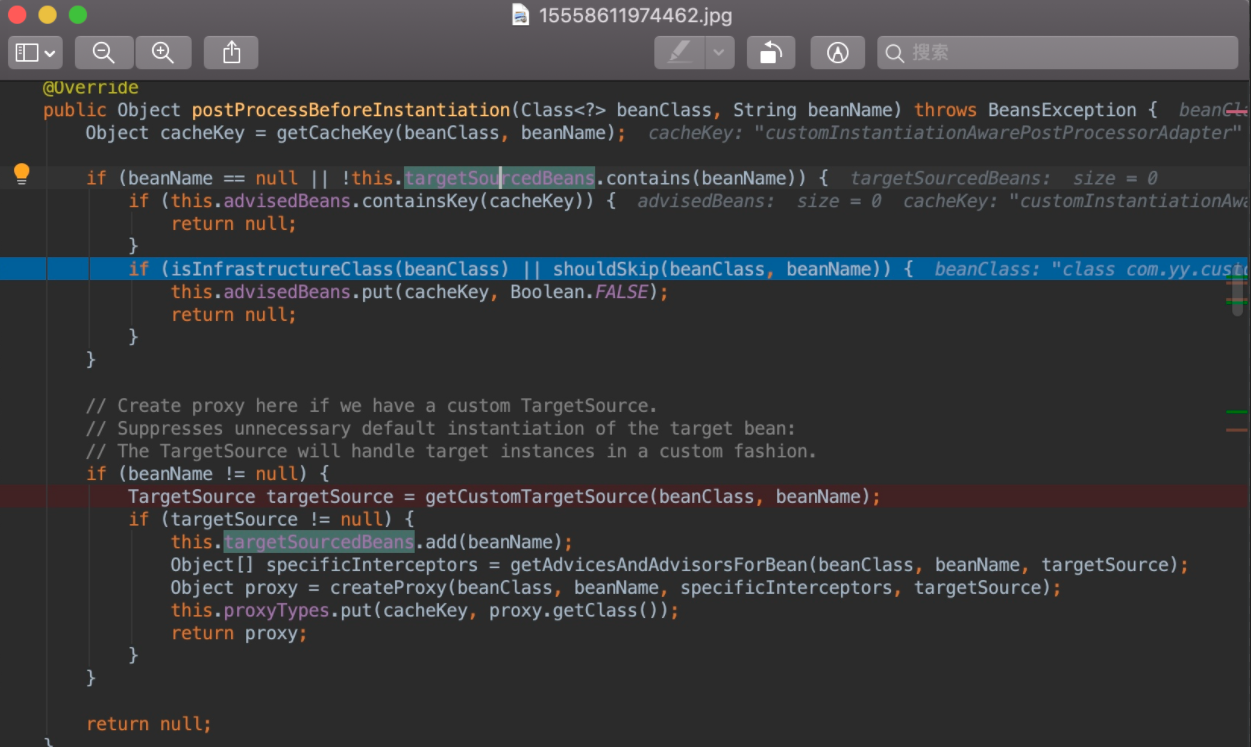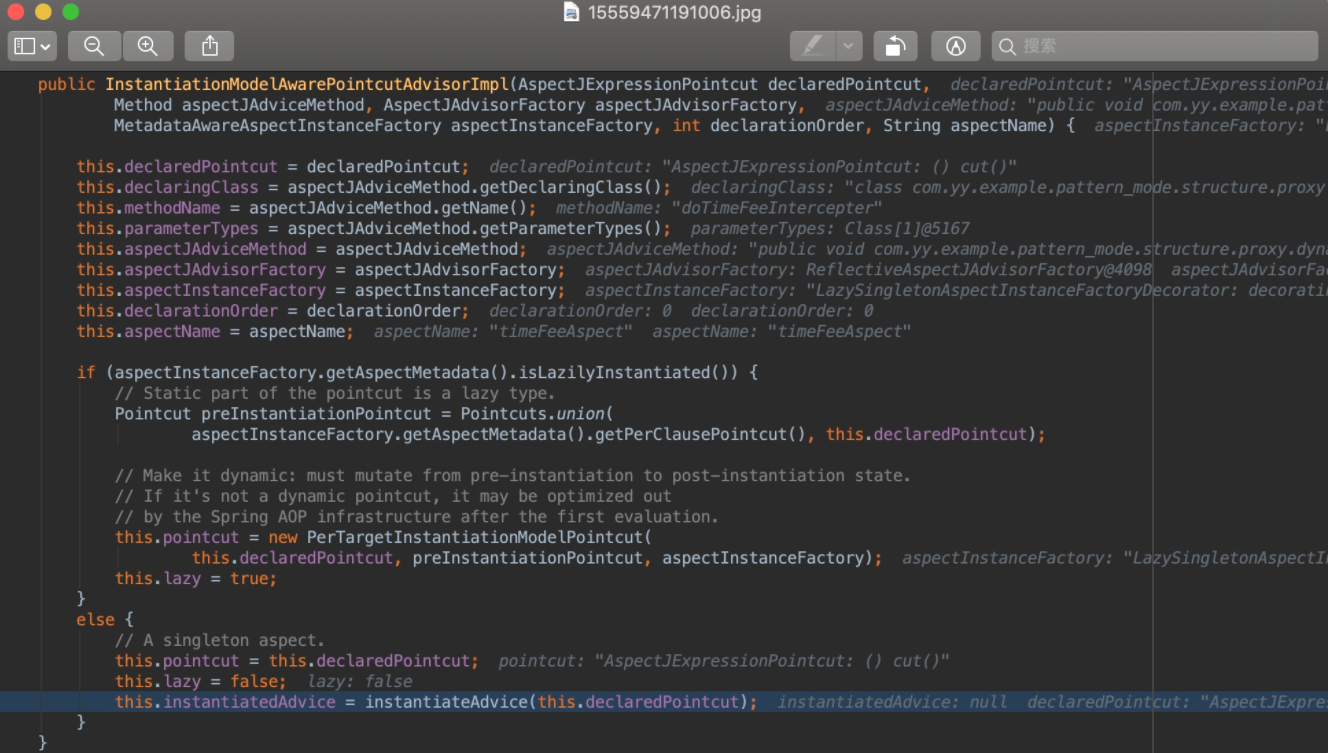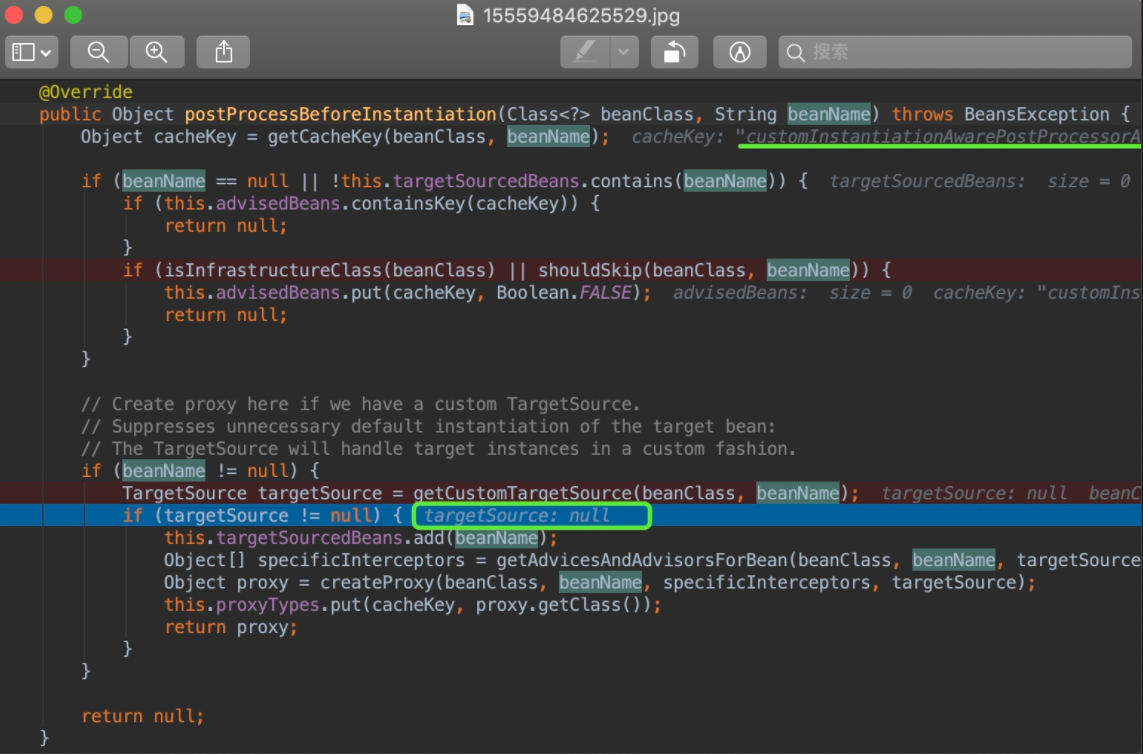此篇是细节知多少-spring boot aop过程解析系列的第二篇,即第二阶段
我们把spring boot的aop实现分为三个阶段
- AnnotationAwareAspectJAutoProxyCreator加载(初始化和实例化)阶段
- AnnotationAwareAspectJAutoProxyCreator使用post-process基于@Aspect验证beanName或beanClass是否可以生成Proxy代理类阶段
- CglibAopProxy或JdkDynamicAopProxy生成Proxy代理类阶段
上一篇中,笔者和大家一起学习了spring boot aop过程解析之阶段一: AnnotationAwareAspectJAutoProxyCreator加载。这篇我们说下阶段二:判断beanName或beanClass是否生成Proxy代理类。在spring boot中,每个类在生成代理类时,都会判断是否可以生成代理类
带着问题学习
带着问题学习往往起到更好的效果
问题:1
2
31. spring aop是如果获取和解析@Aspect注解的
2. spring aop是如果获取和解析@Pointcut注解的
3. @Pointcut注解的execution(expression)存放在哪个对象,什么时候被使用
用例代码
实际工作中,我们都写过@Aspect的代码吧。我们这里定义一个,便于后面知识点阐述1
2
3
4
5
6
7
8
9
10
11
12
13
14@Aspect
@Component
public class TimeFeeAspect {
@Pointcut("execution(* com.yy..rest..*(..))")
public void cut(){}
@Before("cut()")
public void doTimeFeeIntercepter(JoinPoint joinPoint) throws Throwable {
System.out.println("args:" + joinPoint.getArgs());
System.out.println("target" + joinPoint.getTarget().toString());
}
}
如上代码,定义一个Aspect类,目的是对com.yy..rest包下所有的类的访问都经过切面,也就是要走doTimeFeeIntercepter()方法。
下面我们通过debug追踪源码,了解实现原理。
验证和生成代理的入口
通过《spring boot aop过程解析之阶段一: AnnotationAwareAspectJAutoProxyCreator加载》我们知道一个bean要生成代理的入口在AnnotationAwareAspectJAutoProxyCreator的前后置方法中实现。为了方便我定义了一个@Component
CustomInstantiationAwarePostProcessorAdapter。在CustomInstantiationAwarePostProcessorAdapter被创建成bean过程中,由于post-process机制当经过AnnotationAwareAspectJAutoProxyCreator的postProcessBeforeInstantiation()和postProcessAfterInitialization()方法时,都会进行代理类的创建逻辑,即判断是否能创建,如果通过则创建。现在说下这两个方法生成代理类逻辑的源码
postProcessBeforeInstantiation()
进入方法,验证逻辑就开始了,如下图代码
验证逻辑为beanClass是否为aop基础结构类型或者是否可以跳过。由于beanClass不是Pointcut、Advice、Advisor等aop基础结构的子类,所以isInfrastructureClass(beanClass)返回false,代码进入shouldSkip(beanClass, beanName)方法逻辑,这个很重要的方法,逻辑很复杂。进入方法内部1
2
3
4
5
6
7
8
9
10
11
12
13@Override
protected boolean shouldSkip(Class<?> beanClass, String beanName) {
//advisor候选者
List<Advisor> candidateAdvisors = findCandidateAdvisors();
for (Advisor advisor : candidateAdvisors) {
if (advisor instanceof AspectJPointcutAdvisor) {
if (((AbstractAspectJAdvice) advisor.getAdvice()).getAspectName().equals(beanName)) {
return true;
}
}
}
return super.shouldSkip(beanClass, beanName);
}
首先获取advisor候选者列表,然后遍历,如果有AspectName等于beanName,说明这个beanName是Aspect,不用生成代理,方法返回true,否则走父类逻辑(返回false)。查看获取advisor候选者方法findCandidateAdvisors()1
2
3
4
5
6
7
8@Override
protected List<Advisor> findCandidateAdvisors() {
// Add all the Spring advisors found according to superclass rules.
List<Advisor> advisors = super.findCandidateAdvisors();
// Build Advisors for all AspectJ aspects in the bean factory.
advisors.addAll(this.aspectJAdvisorsBuilder.buildAspectJAdvisors());
return advisors;
}
方法内部逻辑很简单,但是意义重大,从两个角度获取Advisor。角度一是从beanFactory容器中获取Advisor类;角度二是从beanFactory容器中获取Aspect类。先看其一1
2
3
4
5
6
7
8
9
10
11
12
13public List<Advisor> findAdvisorBeans() {
String[] advisorNames = BeanFactoryUtils.beanNamesForTypeIncludingAncestors(
this.beanFactory, Advisor.class, true, false);
......
List<Advisor> advisors = new LinkedList<Advisor>();
for (String name : advisorNames) {
if (isEligibleBean(name)) {
advisors.add(this.beanFactory.getBean(name, Advisor.class));
}
}
return advisors;
}
这里只列出了关键代码,可以看到,从beanFactory容器中获取Advisor的子类name集合,然后验证下name是否合格,合格后获取name对应的bean。但是实际debug代码时,这步却没有获取到Advisor的子类,所以返回的是空list。
回到findCandidateAdvisors()方法,看其二
1 | BeanFactoryAspectJAdvisorsBuilder类 |
代码(2)处,判断beanType是否为Aspect,实现逻辑为AnnotationUtils.findAnnotation(clazz, Aspect.class) != null,开头我定义了一个TimeFeeAspect切面类,所以这里只有TimeFeeAspect符合条件,进入if块里面
代码(3)处,构造一个带有Aspect metadata和beanFactory的BeanFactoryAspectInstanceFactory实例,传给关键代码(4)块,看代码(4)内部逻辑1
2
3
4
5
6
7
8
9
10
11
12
13
14
15
16
17
18
19ReflectiveAspectJAdvisorFactory类
public List<Advisor> getAdvisors(MetadataAwareAspectInstanceFactory aspectInstanceFactory) {
Class<?> aspectClass = aspectInstanceFactory.getAspectMetadata().getAspectClass();
String aspectName = aspectInstanceFactory.getAspectMetadata().getAspectName();
MetadataAwareAspectInstanceFactory lazySingletonAspectInstanceFactory =
new LazySingletonAspectInstanceFactoryDecorator(aspectInstanceFactory);
List<Advisor> advisors = new LinkedList<Advisor>();
// 获取aspectClass的方法集合
for (Method method : getAdvisorMethods(aspectClass)) {
Advisor advisor = getAdvisor(method, lazySingletonAspectInstanceFactory, advisors.size(), aspectName); // 关键代码
if (advisor != null) {
advisors.add(advisor);
}
}
return advisors;
}
这个方法的目的很明确:获取advisor。方法解析出入参aspectClass的methods,遍历methods从而获取advisor集合,advisor包含advice和pointcut。
获取methods的方法值得说下1
2
3
4
5
6
7
8
9
10
11
12
13private List<Method> getAdvisorMethods(Class<?> aspectClass) {
final List<Method> methods = new LinkedList<Method>();
ReflectionUtils.doWithMethods(aspectClass, new ReflectionUtils.MethodCallback() {
@Override
public void doWith(Method method) throws IllegalArgumentException {
if (AnnotationUtils.getAnnotation(method, Pointcut.class) == null) {
methods.add(method);
}
}
});
Collections.sort(methods, METHOD_COMPARATOR);
return methods;
}
这段方法逻辑是通用的:获取一个类中带有(不带有)某注解的方法集合,这个逻辑可以轻易的为你实际所用。
根据method获取advisor的getAdvisor(..)方法就是核心逻辑了,看其内部1
2
3
4
5
6
7
8
9
10
11
12
13ReflectiveAspectJAdvisorFactory类
public Advisor getAdvisor(Method candidateAdviceMethod, MetadataAwareAspectInstanceFactory aspectInstanceFactory,
int declarationOrderInAspect, String aspectName) {
// 验证aspectClass是否有@Aspect注解,其父类是否没有Aspect注解
validate(aspectInstanceFactory.getAspectMetadata().getAspectClass());
// 核心:生成PointCut
AspectJExpressionPointcut expressionPointcut = getPointcut(
candidateAdviceMethod, aspectInstanceFactory.getAspectMetadata().getAspectClass());
return new InstantiationModelAwarePointcutAdvisorImpl(expressionPointcut, candidateAdviceMethod,
this, aspectInstanceFactory, declarationOrderInAspect, aspectName);
}
方法首先验证后,根据adviceMethod和aspectClass生成PointCut,然后构造成InstantiationModelAwarePointcutAdvisorImpl实例。首先看生成PointCut的逻辑1
2
3
4
5
6
7
8
9
10
11
12
13
14
15
16
17
18
19
20
21
22
23
24
25
26
27
28ReflectiveAspectJAdvisorFactory类
private AspectJExpressionPointcut getPointcut(Method candidateAdviceMethod, Class<?> candidateAspectClass) {
// 获取method的Advice,即Before.class, Around.class, After.class, AfterReturning.class, AfterThrowing.class
// AspectJAnnotation包括具体类型的Advice和PointCut的expression
AspectJAnnotation<?> aspectJAnnotation =
AbstractAspectJAdvisorFactory.findAspectJAnnotationOnMethod(candidateAdviceMethod);
// 构造PointCut
AspectJExpressionPointcut ajexp =
new AspectJExpressionPointcut(candidateAspectClass, new String[0], new Class<?>[0]);
ajexp.setExpression(aspectJAnnotation.getPointcutExpression());
ajexp.setBeanFactory(this.beanFactory);
return ajexp;
}
AbstractAspectJAdvisorFactory类
protected static AspectJAnnotation<?> findAspectJAnnotationOnMethod(Method method) {
Class<?>[] classesToLookFor = new Class<?>[] {
Before.class, Around.class, After.class, AfterReturning.class, AfterThrowing.class, Pointcut.class};
// 匹配方法的Advice类型:Before.class, Around.class, After.class, AfterReturning.class, AfterThrowing.class, Pointcut.class
// 匹配即返回
for (Class<?> c : classesToLookFor) {
AspectJAnnotation<?> foundAnnotation = findAnnotation(method, (Class<Annotation>) c);
if (foundAnnotation != null) {
return foundAnnotation;
}
}
return null;
}
生成PointCut后,代码回到ReflectiveAspectJAdvisorFactory.getAdvisor()方法的构造InstantiationModelAwarePointcutAdvisorImpl实例部分,查看其构造方法
可以看到,InstantiationModelAwarePointcutAdvisorImpl类包含AspectJExpressionPointcut类型的pointcut名属性,adviceName,aspectJAdviceMethod切面方法等属性。同时也会根据advice的type生成对应的xxxAdvice对象。看最后一行instantiatedAdvice的解析代码1
2
3
4
5
6
7
8
9
10
11
12
13
14
15
16
17
18
19
20
21
22
23
24
25
26
27
28
29
30
31
32
33
34
35
36
37
38
39
40
41
42
43
44
45
46
47
48
49
50
51
52
53
54
55
56
57
58
59
60
61private Advice instantiateAdvice(AspectJExpressionPointcut pcut) {
return this.aspectJAdvisorFactory.getAdvice(this.aspectJAdviceMethod, pcut,
this.aspectInstanceFactory, this.declarationOrder, this.aspectName);
}
public Advice getAdvice(Method candidateAdviceMethod, AspectJExpressionPointcut expressionPointcut,
MetadataAwareAspectInstanceFactory aspectInstanceFactory, int declarationOrder, String aspectName) {
Class<?> candidateAspectClass = aspectInstanceFactory.getAspectMetadata().getAspectClass();
AspectJAnnotation<?> aspectJAnnotation =
AbstractAspectJAdvisorFactory.findAspectJAnnotationOnMethod(candidateAdviceMethod);
AbstractAspectJAdvice springAdvice;
switch (aspectJAnnotation.getAnnotationType()) {
case AtBefore:
springAdvice = new AspectJMethodBeforeAdvice(
candidateAdviceMethod, expressionPointcut, aspectInstanceFactory);
break;
case AtAfter:
springAdvice = new AspectJAfterAdvice(
candidateAdviceMethod, expressionPointcut, aspectInstanceFactory);
break;
case AtAfterReturning:
springAdvice = new AspectJAfterReturningAdvice(
candidateAdviceMethod, expressionPointcut, aspectInstanceFactory);
AfterReturning afterReturningAnnotation = (AfterReturning) aspectJAnnotation.getAnnotation();
if (StringUtils.hasText(afterReturningAnnotation.returning())) {
springAdvice.setReturningName(afterReturningAnnotation.returning());
}
break;
case AtAfterThrowing:
springAdvice = new AspectJAfterThrowingAdvice(
candidateAdviceMethod, expressionPointcut, aspectInstanceFactory);
AfterThrowing afterThrowingAnnotation = (AfterThrowing) aspectJAnnotation.getAnnotation();
if (StringUtils.hasText(afterThrowingAnnotation.throwing())) {
springAdvice.setThrowingName(afterThrowingAnnotation.throwing());
}
break;
case AtAround:
springAdvice = new AspectJAroundAdvice(
candidateAdviceMethod, expressionPointcut, aspectInstanceFactory);
break;
case AtPointcut:
if (logger.isDebugEnabled()) {
logger.debug("Processing pointcut '" + candidateAdviceMethod.getName() + "'");
}
return null;
default:
···
}
// Now to configure the advice...
springAdvice.setAspectName(aspectName);
springAdvice.setDeclarationOrder(declarationOrder);
String[] argNames = this.parameterNameDiscoverer.getParameterNames(candidateAdviceMethod);
if (argNames != null) {
springAdvice.setArgumentNamesFromStringArray(argNames);
}
springAdvice.calculateArgumentBindings();
return springAdvice;
}
整个方法就是为了获取Advice,根据切面方法(即TimeFeeAspect.doTimeFeeIntercepter)上的advice注解type返回对应的xxxxAdvice实例。这里doTimeFeeIntercepter方法上注解了@Before advice,所以我们得到是AspectJMethodBeforeAdvice对象。AspectJMethodBeforeAdvice包含advice method, pointcut, aspect class name。AspectJMethodBeforeAdvice相当于interceptor。当生成proxy代理类时,AspectJMethodBeforeAdvice就是proxy代理类的interceptor,proxy的切入的方法就是AspectJMethodBeforeAdvice的advice method,即TimeFeeAspect.doTimeFeeIntercepter方法。这样,就把目标类的被切入方法和aspect的想切入的方法关联起来了。所以每次程序走到目标类的被切入方法时,都会先走aspect的想切入的方法。
这样InstantiationModelAwarePointcutAdvisorImpl对象就new出来了。包含属性如下图
所以,对外暴露的advisor其实就是InstantiationModelAwarePointcutAdvisorImpl对象,当生成proxy代理类的时候传进去的advisor也就是InstantiationModelAwarePointcutAdvisorImpl对象了。当我们讲解spring boot aop过程解析之阶段三:生成Proxy代理类时接着说这里
到这,Advice class获取到了,Advice的PointCut也拿到了,但是PointCut自身的表达式(Expression)值还没有拿到。接着走代码
回到postProcessBeforeInstantiation()方法,由于我们找到了Advisor,所以shouldSkip(beanClass, beanName)返回false,逻辑往下走。又由于getCustomTargetSource(beanClass, beanName)返回null,所以这步没有生成入参beanName或beanClass的代理
这样,postProcessBeforeInstantiatioin()方法的逻辑就走完了。但是beanName或beanClass还有一次生成代理类的机会,就是postProcessAfterInitialization()方法提供的
postProcessAfterInitialization()
我们在方法开始处打个断点,F9 debug放开,断点进入postProcessAfterInitialization()方法
可以看到:wrapIfNecessary方法是核心,查看其内部代码1
2
3
4
5
6
7
8
9
10
11
12
13
14
15
16
17
18
19
20
21
22
23
24
25protected Object wrapIfNecessary(Object bean, String beanName, Object cacheKey) {
if (beanName != null && this.targetSourcedBeans.contains(beanName)) {
return bean;
}
if (Boolean.FALSE.equals(this.advisedBeans.get(cacheKey))) {
return bean;
}
if (isInfrastructureClass(bean.getClass()) || shouldSkip(bean.getClass(), beanName)) {
this.advisedBeans.put(cacheKey, Boolean.FALSE);
return bean;
}
// Create proxy if we have advice.
Object[] specificInterceptors = getAdvicesAndAdvisorsForBean(bean.getClass(), beanName, null);
if (specificInterceptors != DO_NOT_PROXY) {
this.advisedBeans.put(cacheKey, Boolean.TRUE);
Object proxy = createProxy(
bean.getClass(), beanName, specificInterceptors, new SingletonTargetSource(bean));
this.proxyTypes.put(cacheKey, proxy.getClass());
return proxy;
}
this.advisedBeans.put(cacheKey, Boolean.FALSE);
return bean;
}
可以看到,方法上半部分与postProcessBeforeInstantiation()方法相同,刚才的分析就是shouldSkip(bean.getClass(), beanName)方法,所以我们直接看getAdvicesAndAdvisorsForBean(bean.getClass(), beanName, null)。这个方法获取Advisor,看其内部逻辑1
2
3
4
5
6
7
8
9
10
11
12protected Object[] getAdvicesAndAdvisorsForBean(Class<?> beanClass, String beanName, TargetSource targetSource) {
List<Advisor> advisors = findEligibleAdvisors(beanClass, beanName);
return advisors.toArray();
}
protected List<Advisor> findEligibleAdvisors(Class<?> beanClass, String beanName) {
// 获取Advisor候选者
List<Advisor> candidateAdvisors = findCandidateAdvisors();
List<Advisor> eligibleAdvisors = findAdvisorsThatCanApply(candidateAdvisors, beanClass, beanName);
extendAdvisors(eligibleAdvisors);
return eligibleAdvisors;
}
findEligibleAdvisors()方法首先获取Advisor候选者(findCandidateAdvisors()的逻辑在postProcessBeforeInstantiation()方法分析时已经说过),然后通过findAdvisorsThatCanApply()方法检验这些Advisor候选者对beanClass来说是否是合格的Advisor。这里就很关键了,我们看其内部代码1
2
3
4
5
6
7
8
9
10
11
12
13
14
15
16AopUtils 类
protected List<Advisor> findAdvisorsThatCanApply( List<Advisor> candidateAdvisors, Class<?> beanClass, String beanName) {
return AopUtils.findAdvisorsThatCanApply(candidateAdvisors, beanClass);
}
public static List<Advisor> findAdvisorsThatCanApply(List<Advisor> candidateAdvisors, Class<?> clazz) {
List<Advisor> eligibleAdvisors = new LinkedList<Advisor>();
···
boolean hasIntroductions = !eligibleAdvisors.isEmpty();
for (Advisor candidate : candidateAdvisors) {
if (canApply(candidate, clazz, hasIntroductions)) {
eligibleAdvisors.add(candidate);
}
}
return eligibleAdvisors;
}
方法重点是条件判断。这里只列出部分代码,其实方法将候选者Advisor分为两拨,一拨是IntroductionAdvisor,然后条件判断canApply(candidate, clazz);另一拨是其他Advisor,然后条件判断canApply(candidate, clazz, hasIntroductions),我们debug时走的后一个条件判断方法逻辑,看其内部代码逻辑1
2
3
4
5
6
7
8
9
10
11
12
13
14
15
16
17
18
19
20
21
22
23
24
25
26
27
28
29
30
31
32
33
34
35
36
37
38
39
40
41
42AopUtils 类
public static boolean canApply(Advisor advisor, Class<?> targetClass, boolean hasIntroductions) {
if (advisor instanceof PointcutAdvisor) {
PointcutAdvisor pca = (PointcutAdvisor) advisor;
return canApply(pca.getPointcut(), targetClass, hasIntroductions);
}
}
AopUtils 类
public static boolean canApply(Pointcut pc, Class<?> targetClass, boolean hasIntroductions) {
// 使用Pointcut匹配targetClass,此时的Pointcut.pointcutExpression赋值就隐藏在pc.getClassFilter()中
if (!pc.getClassFilter().matches(targetClass)) {
return false;
}
MethodMatcher methodMatcher = pc.getMethodMatcher();
if (methodMatcher == MethodMatcher.TRUE) {
// No need to iterate the methods if we're matching any method anyway...
return true;
}
IntroductionAwareMethodMatcher introductionAwareMethodMatcher = null;
if (methodMatcher instanceof IntroductionAwareMethodMatcher) {
introductionAwareMethodMatcher = (IntroductionAwareMethodMatcher) methodMatcher;
}
//(1)
Set<Class<?>> classes = new LinkedHashSet<Class<?>>(ClassUtils.getAllInterfacesForClassAsSet(targetClass));
classes.add(targetClass);
for (Class<?> clazz : classes) {
Method[] methods = ReflectionUtils.getAllDeclaredMethods(clazz);
for (Method method : methods) {
if ((introductionAwareMethodMatcher != null &&
introductionAwareMethodMatcher.matches(method, targetClass, hasIntroductions)) ||
methodMatcher.matches(method, targetClass)) {//(2)
return true;
}
}
}
return false;
}
整个方法都在判断targerClass是否匹配这个pointcut,由于此时的pointcut.pointcutExpression还没有赋值呢,所以在判断匹配之前,需要pointcut.pointcutExpression赋值,所以整个AopUtis.canApply分为两部分:
- 给pointcut.pointcutExpression赋值
- targerClass匹配pointcut检验
而第一部分的赋值在pc.getClassFilter()里,看方法代码
1 | AspectJExpressionPointcut类 |
以上代码的核心逻辑就是给AspectJExpressionPointcut.PointcutExpression赋值,这个就是开篇时的例子代码:@Pointcut(“execution( com.yy..rest..(..))”)。赋值操作是通过PointcutParser、PatternParser和Pointcut来完成的。具体的赋值过程入口为pc = pc.resolve(resolutionScope)。resolve方法调用栈:1
2
3
4
5
6
7
8Pointcut.resolve()
-this.resolveBindings()
--searchType.findPointcut(name)
searchType就是TimeFeeAspect,name就是cut方法名
... 经过getPointcuts().iterator循环 ...
---Java15ReflectionBasedReferenceTypeDelegate.getDeclaredPointcuts()
----AjType.getDeclaredPointcuts()
-----Method[] methods = clazz.getDeclaredMethods()
clazz就是TimeFeeAspect,循环methods,判断method是否有@Pointcut注解:Pointcut pcAnn = method.getAnnotation(Pointcut.class);
拿到pcAnn.value()。构造成一个Pointcut,再构造成一个PointcutExpressionImpl,再构造成一个PointcutImpl。最后AspectJExpressionPointcut.PointcutExpression被赋值了。切入点的表达式已经有了,接下来要做的自然是使用表达式来验证目标了。这部分即是AopUtils.canApply()方法的第二部分的逻辑。
下面看AopUtils.canApply()方法的第二部分:targerClass匹配pointcut检验,首先看pc.getClassFilter().matches(targetClass)如果匹配,代码往下走;如果不匹配,直接返回false。接着走(2)处代码,即获取targerClass的所有接口和父类,遍历每个类的每个方法,使用Pointcut的expression去match每个方法,一旦有匹配上,返回true,退出遍历。所以匹配的逻辑就是重点了。这里列下关键的代码段1
2
3
4
5
6
7
8
9
10
11
12
13
14
15
16
17
18
19
20
21
22
23
24
25
26
27
28
29
30
31
32
33
34
35
36
37
38
39
40
41
42
43
44
45
46
47
48
49
50
51
52
53
54
55AspectJExpressionPointcut类
public boolean matches(Method method, Class<?> targetClass, boolean beanHasIntroductions) {
Method targetMethod = AopUtils.getMostSpecificMethod(method, targetClass);
ShadowMatch shadowMatch = getShadowMatch(targetMethod, method); //关键代码
if (shadowMatch.alwaysMatches()) {
return true;
}
else if (shadowMatch.neverMatches()) {
return false;
}
}
// 可以看到这个方法中使用了双重检查机制(double check),double check结合synchronized可以有效的
// 避免锁的竞争,这个组合我们可以在很多地方使用,想想在你的项目中使用它,很棒,面试也是高频知识点
private ShadowMatch getShadowMatch(Method targetMethod, Method originalMethod) {
// Avoid lock contention for known Methods through concurrent access...
ShadowMatch shadowMatch = this.shadowMatchCache.get(targetMethod);
if (shadowMatch == null) {
synchronized (this.shadowMatchCache) {
shadowMatch = this.shadowMatchCache.get(targetMethod);
if (shadowMatch == null) {
// pointcutExpression对象包含KindedpPointcut类型的属性pointcut "execution(* com.yy..rest..*(..))"
// KindedpPointcut包含SignaturePattern类型的属性signature "* com.yy..rest..*(..)"
shadowMatch = this.pointcutExpression.matchesMethodExecution(methodToMatch); //关键代码
}
}
}
}
PointcutExpressionImpl类
private ShadowMatchImpl getShadowMatch(Shadow forShadow) {
org.aspectj.util.FuzzyBoolean match = pointcut.match(forShadow); //关键代码
Test residueTest = Literal.TRUE;
ExposedState state = getExposedState();
if (match.maybeTrue()) {
residueTest = pointcut.findResidue(forShadow, state);
}
ShadowMatchImpl sm = new ShadowMatchImpl(match, residueTest, state, parameters);
sm.setMatchingContext(this.matchContext);
return sm;
}
WildTypePattern类,真正的验证逻辑就在这个类。
protected boolean matchesExactly(ResolvedType type, ResolvedType annotatedType) {
String targetTypeName = type.getName();
// System.err.println("match: " + targetTypeName + ", " + knownMatches); //Arrays.asList(importedPrefixes));
// Ensure the annotation pattern is resolved
annotationPattern.resolve(type.getWorld());
// 四个方法的&&结果
return matchesExactlyByName(targetTypeName, type.isAnonymous(), type.isNested()) && matchesParameters(type, STATIC)
&& matchesBounds(type, STATIC)
&& annotationPattern.matches(annotatedType, type.temporaryAnnotationTypes).alwaysTrue();
}
matchesExactlyByName(..)比较全限定类名是否匹配。会把pointcut的expression和目标类的全限定名变为.分隔的数组,对应下标值依次比较。像这样:pattern[pi].matches(target[ti])。matchesParameters(..)比较方法的参数是否匹配matchesBounds(..)比较方法或参数带?时是否匹配annotationPattern(..)比较方法或参数的注解是否匹配
当然,根据&&短路原则,前面的方法返回false时,后面的方法不用走了,直接返回结果。本例debug时,pointcut为”execution( com.yy..rest..(..)),目标target类为com.yy.custom_spring.custom5.CustomInstantiationAwarePostProcessorAdapter,两者比较,包名不一样,所以不匹配,返回false
另外,targerClass是否匹配pointcut的过程我们也可以通过debug的调用栈来观察调用关系,如下图。这样,你自己debug走代码的时候体会的更直接

到这里,spring boot aop过程解析之阶段二判断beanName或beanClass是否生成Proxy代理类就走完了。没有面面俱到,但关键地方都有提到。如有任何疑问和问题,欢迎一起交流进步,可以留言或邮箱 skyler_11@163.com yaoyihao1@gmail.com
问题回答
- 针对文章开头的问题我们可以回答下了:
问题:1
2
3
4
51. spring aop是如果获取和解析Aspect(advisor)切面类的
2. spring aop是如果获取和解析@Pointcut注解的
3. @Pointcut注解的execution(expression)存放在哪个对象,什么时候被使用
4. @Before注解spring aop是如果获取和解析的,spring aop如何找到@Before对应的Pointcut?
5. 什么时候什么位置在真实对象方法前后加上代理逻辑的
答案:1
2
3
4
5
6
7
81. spring是从两个方面获取Aspect(advisor)切面类的
一方面:String[] advisorNames = BeanFactoryUtils.beanNamesForTypeIncludingAncestors(this.beanFactory, Advisor.class, true, false);
另一方面:String[] beanNames = BeanFactoryUtils.beanNamesForTypeIncludingAncestors(this.beanFactory, Object.class, true, false);然后遍历beanNames,找到对应的bean,看看这个bean是否有@Aspect注解,有就是Aspect(advisor)
2. spring是找到并解析Aspect类中Advice方法的参数,如@Before("cut()") public void doTimeFeeIntercepter方法。具体的解析位置是AspectJExpressionPointcut=ReflectiveAspectJAdvisorFactory.getPointcut()方法,这时的AspectJExpressionPointcut只有值cut(),表达式还没有赋值呢。然后再根据cut()重新解析Aspect类,找到Expression并赋值给AspectJExpressionPointcut,这步是在Pointcut.resolve()中完成的
3. execution(expression)存放在KindedPointcut对象中,在验证targerClass是否匹配时被使用
如有任何疑问和问题,欢迎一起交流进步,可以留言或邮箱 skyler_11@163.com yaoyihao1@gmail.com


